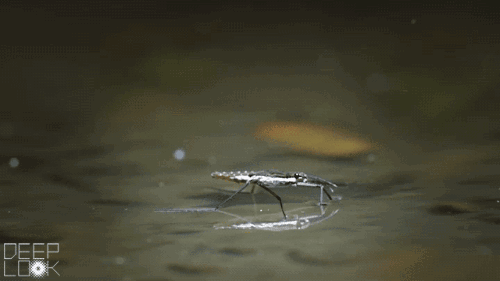Surface tension is a phenomenon that occurs on the surface of liquids, such as water, forming a thin film.
When water, in a liquid state, occupies a container, we can perceive the separation between the liquid and the environment. This is because the interaction between water molecules on the surface is different from the interactions inside the liquid.
On the surface, a water molecule interacts with the molecules on the sides and below it. Inside, a molecule is surrounded by other molecules and there is interaction in all directions through hydrogen bonds.
It is due to this property that we observe the phenomenon of drop formation. Because of this, it is also possible for insects to walk on water.
What is surface tension?
It is the formation of a thin film under a liquid due to the unequal attractions between the molecules that compose it. This phenomenon occurs more accentuated in liquids that have intense intermolecular forces , such as water.
The interactions between the species of a liquid are called cohesive forces. While the molecules inside a liquid are attracted to neighboring molecules in all directions, the molecules on the surface interact with the molecules below and beside them.
See how surface tension occurs in water.

Water (H 2 O) is a polar molecule formed by 2 hydrogen atoms (positive poles) and an oxygen atom (negative pole) joined by covalent bonds . The positive pole of a molecule is attracted by the negative pole of the neighboring molecule, forming hydrogen bonds.
This type of interaction inside the liquid is distributed in all directions. On the surface, the forces are directed downwards and to the sides, because above them there are no water molecules. This causes the surface molecules to become more cohesive and create an elastic film.
The unit of surface tension is given by the quotient between unit of force and unit of length, the most adopted being dyne / centimeter (dyne / cm) and newton / meter (N / m).
The water has a high surface tension, whose value is 72.75 dyne / cm. However, mercury, a liquid metal, has a surface tension approximately 7 times greater than water, 475 dyne / cm.
Phenomena caused by surface tension
Surface tension is responsible for some phenomena that we observe on a daily basis. The main ones are:
Animals walking on water

Insects, spiders and other animals are able to walk or rest on the water because at the ends of their paws there are hairs coated with a fatty substance and, therefore, they cannot penetrate between the water molecules that are united on the surface.
Water droplet formation

The water droplets are spherical due to the contraction in the surface molecules caused by the surface tension. The sphere occurs because this is the geometric shape in which there is the least relationship between surface area and volume. Thus, the spherical shape keeps the least number of water molecules in contact with the air.
Exercises on surface tension of water
1 . A surfactant is a substance that acts on another one to change:
a) Osmolarity.
b) Surface tension.
c) Electrophoresis.
d) Viscosity.
e) Osmotic pressure.
Answer
Correct alternative: b) Surface tension.
a) WRONG. Osmolarity is related to the amount of solute particles that is contained in a given volume of solvent.
b) CORRECT. Both detergents and soaps decrease the surface tension of the water and are generically called surfactants, because the molecules of these materials are placed between the water molecules and decrease the surface tension.
c) WRONG. Electrophoresis is a technique for separating molecules according to charges.
d) WRONG. Viscosity is a physical property that determines the resistance of a fluid to flow.
e) WRONG. Osmotic pressure is a colligative property that corresponds to the pressure that must be exerted in a system to prevent osmosis from occurring spontaneously.
2 . The surface tension of liquids depends directly on processes of interaction between molecules, such as hydrogen bonding, for example. Which of the substances below has the highest surface tension?
a) benzene
b) octane
c) ethyl alcohol
d) carbon tetrachloride
e) ethanoic acid
Answer
Correct alternative: e) ethanoic acid.
a) WRONG. Benzene is a hydrocarbon, a nonpolar molecule, and does not make hydrogen bonds.
b) WRONG. Octane is a hydrocarbon and is therefore an apolar molecule that does not perform hydrogen bonds.
c) WRONG. Ethyl alcohol is a slightly polar compound that can make hydrogen bonds, but the interaction between the molecules is limited.
d) WRONG. Carbon tetrachloride is an apolar organic compound and therefore does not perform hydrogen bonds.
e) CORRECT. The carboxylic acid (-COOH) functional group can perform hydrogen bonds with both oxygen and hydroxyl hydrogen.

